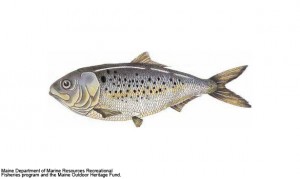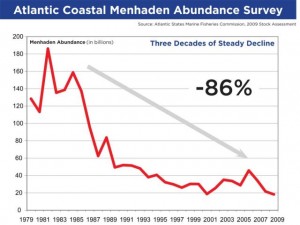
Despite their small size and plain appearance, menhaden have been called “the most important fish in the sea” because numerous coastal fish species rely on them for food. Although they aren’t typically eaten by humans, there is still a huge fishery for them for bait, aquaculture food, and oil. That fishery has been essentially unregulated, allowing fishermen to take as many as they want. Recently, there’s been a campaign among certain environmental groups to fix this problem and put catch limits in place for menhaden.
I was surprised to see PolitiFact, a non-partisan political fact-checking website, address this issue. I’ve checked PolitiFact pretty regularly for years, and I’ve never seen them cover a topic like this before. They focused on a claim by the Pew Environment Group that “In recent years, menhaden numbers along our coast have plummeted by 90 percent.” While I admit I am not familiar with specific details of menhaden population trends, anyone who has paid any attention at all to the ocean knows that we’re overfishing at alarming rates. According to the UN Food and Agriculture Organization, approximately 1/3 of all global fisheries are depleted or overexploited, many by more than the 90% referenced for menhaden. Shockingly, PolitiFact called the claim by Pew “mostly false”. Their reasoning for this ruling is even more ridiculous than the ruling itself:
“Whether the population declined by 90 percent, as Pew asserts, depends on where you want to start calculating and when you want to stop.The Pew ad says the 90-percent decline was “in recent years.” It gives no time frame. If you think of “recent” as the last 10 years, the drop from 1999 to 2008 has been 43 percent, far from 90 percent, according to the chart Pew referenced.Over the last 20 years, it’s been 76 percent.To show a drop close to 90 percent, you have to start at 1982, when the estimated number of menhaden was 20.2 billion.”
This is a classic case of “shifting baselines”- how severe the decline is obviously depends on when you start counting. If you “think as recent as the last ten years”, as PolitiFact suggests, the decline from 1999 to 2008 is less severe than the decline from 1982 to present. What PolitiFact leaves out, however, is that the % decline from 1999 to 2008 is less severe than the 1982-present decline because so many of the fish were already gone by 1999! Of course the percentage of decline between an extremely depleted and a severely depleted population is less severe than the percentage of decline between a (relatively) healthy population and a severely depleted population!
For a simplistic example, consider having a population with biomass of 100 tons. Over 20 years, the population is reduced to 10 tons. Over the next ten years, the population is reduced to 6 tons. The % decline from 10 tons to 6 is only 40%. However, the percentage from when we started to where we are now is over 90%, and that’s what really matters in terms of assessing the health of a fish population!

The definition PolitiFact uses for “Mostly False” is “The statement contains some element of truth but ignores critical facts that would give a different impression.” That’s nonsense. Regardless of whether you consider “30 years” to be “recent” (and in terms of evolutionary or long-term fisheries management time, it certainly is), the central point that Pew made is that menhaden are overexploited, menhaden populations are seriously declining, and better management is needed, which is all unambiguously true. If anything, this falls much closer to the category of “Mostly True”, defined by PolitiFact as “The statement is accurate but needs clarification or additional information.” It also falls under the category of “I need to take an introductory marine biology class”, which PolitiFact strangely has not used to date.
Fortunately, the Atlantic States Marine Fisheries Commission voted Friday to improve the management regulations for menhaden. In the meantime, I’ve written to PolitiFact asking them to change the rating.

I think Politifact’s messed-up reasoning actually reflects the way many people (even some fishermen) view stock assessments. It literally is shifting baselines in action. Way to get a great teaching moment out of it, and good to see managers finally addressing this species.
this line of thinking also affects the way agencies–government or otherwise–obscure definitions when discussing the natural environment. it allows them to use the vaguest terms possible to give the illusion actual restoration and management are taking place.
The article’s author, David Shiffman, alleges that Politifact’s conclusions are “completely wrong,” but he openly admits that he is “not familiar with specific details of menhaden population trends.” The author demonstrates this absence of knowledge throughout his writing, ultimately employing a comparably misguided rationale to that used by Pew. In turn, both Pew and Mr. Shiffman misrepresent the status of Atlantic menhaden.
Mr. Shiffman accuses Politifact of “shifting baselines” to arbitrarily reach their conclusion that Pew Environment Group had misrepresented menhaden-related statistics in a recent ad, but when the full time series of the menhaden fishery is examined, it reveals that Pew Environment has actually manipulating the years to create a dramatic pattern in the menhaden population. If Mr. Shiffman had taken the time to examine the complete timeline of available data, he would find that the alleged 90 percent decline is completely selective, and does not represent the patterns that have occurred over the complete history of the fishery.
Over the 50-plus years that data on menhaden biomass has been recorded by the Atlantic States Marine Fisheries Commission (ASMFC), biomass has fluctuated based on the strength of menhaden recruitment (the number of menhaden that are born). Current biomass figures are similar to the levels seen in the late 1960s, when biomass was lower, but the levels that followed in the 1970s and 1980s were the highest on record. The full time series shows that menhaden recruitment is highly variable by year, and periods of high recruitment, such as those naturally resulting after years of low recruitment, are more likely to be the result of favorable environmental conditions than a reduction in fishing activity.
Because Pew starts to chart the decline at the record-high biomass in 1983, fluctuations in menhaden biomass that occurred over the total 50 years of available data are left out of the picture entirely. The decline that Pew cites is simply part of an alternating cycle of strong and weak recruitment.
The largest flaw in Mr. Shiffman’s logic is assuming that Pew’s initial argument was true solely based upon the statistic that “approximately 1/3 of all global fisheries are depleted or overexploited.” Tying to compare aggregate global fisheries data to a single fishery is completely illogical, especially when considering that the United States comprises only a very small portion of these globally overexploited populations. “The U.S. is actually a big success story in rebuilding fish stocks,” explained Dr. Ray Hilborn, of the University of Washington, in a September Washington Post article. “In parts of the world, like in the North Atlantic, we’re starting to see reduced fishing pressure after 150 years of being fished hard.” A 2009 Science study by Dr. Hilborn indicated that a majority of the third “of all global fisheries” that are depleted or recovering are found in Africa and Asia, making Mr. Shiffman’s assertion that “anyone who has paid any attention at all to the ocean” should assume that the menhaden population is overfished, despite other contradictory evidence, incorrect.
(Please note that Saving Menhaden Fisheries, of whom this commenter is linked to, is sponsored by the Menhaden Fisheries Coalition which is comprised of, among others, Omega Protein Inc. Omega Protein is the owner of the only Menhaden processing plant in the United States. ~Ed.)